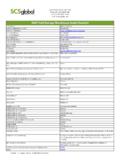Transcription of Understanding & Applying Hall Effect Sensor …
1 Application Report SLIA086 July 2014 1 Understanding & Applying hall Effect Sensor Datasheets Ross Eisenbeis Motor Drive Business Unit ABSTRACT hall Effect sensors measure magnetic fields, and their datasheet parameters can initially be difficult to understand and apply toward system design. This article provides a baseline of information. Units A magnet produces a magnetic field that travels from the North pole to the South pole. The total amount of field through a 2-dimensional slice is the flux , in units of weber. Webers per square meter describes flux density, in units of tesla (T). The unit of gauss (G) also describes flux density, where 1 T = 10000 G. In millitesla, 1 mT = 10 G. Tesla is the official SI unit, and it s used by TI datasheets, but many other sources use gauss.
2 Practical Concepts The closer you are to a magnet, the higher the flux density. The flux density at the surface of the magnet depends on its material and the magnetization amount. Typical magnets have surface fields between 40 to 600 mT. At a given distance, physically large magnets project a larger flux density. Polarity The symbol B is used for flux density. TI hall sensors use the convention that magnetic fields traveling from the bottom of the device through the top are positive B , and fields traveling from the top to the bottom of the device are negative B . Only the perpendicular vector component of the magnetic field is sensed by the internal element. B > 0 mTSNB < 0 mTSN Figure 1. Polarity of field directions Digital hall Sensor Functionality 2 Digital hall Sensor Functionality Digital hall sensors have an open-drain output that pulls Low if B exceeds the threshold BOP (the Operate Point).
3 The output then stays Low until B decreases below the threshold BRP (the Release Point), and then the output becomes High-Impedance. An external pull-up resistor is normally used. BOP and BRP are always separated with hysteresis (Bhys), which prevents noise-induced toggling at a threshold. Output (V)BOPBRPBOFBHYSB (mT) Figure 2. B-field response of the DRV5023 Like all datasheet parameters, the actual B thresholds vary due to semiconductor process variation, operating voltage, and temperature. PARAMETER MIN TYP MAX UNIT BOP Operate point 3 12 mT BRP Release point 1 4 Bhys Hysteresis; Bhys = (BOP BRP) 3 7 BO Magnetic offset; BO = (BOP + BRP) / 2 A magnet and hall Sensor should be selected so that the field at the Sensor exceeds the specified max-BOP, in order to guarantee that the magnetic threshold is crossed.
4 Design Example with Digital hall Sensors 3 Design Example with Digital hall Sensors Consider the switches used to control power windows in a vehicle. Each rocker switch could contain two small magnets for the forward and backward directions, along with a digital hall Sensor mounted below each one. The goal here is to ensure that when the button is not pushed, the B-field at the Sensor is below the min-BRP, and pushing the button brings the B-field at the Sensor above the max-BOP. This involves a combination of magnet and Sensor selection, considering the distance of separation. When selecting a DRV5023 switch, there are two different versions: PARAMETER MIN TYP MAX UNIT DRV5023AJ BOP 3 12 mT BRP 1 4 DRV5023BI BOP 6 24 BRP 2 8 When choosing a magnet, the designer must select the material and size.
5 Available materials include ceramics and different ferromagnetic metal alloys, and there are tradeoffs in flux density, temperature performance, mechanical characteristics, and cost. The physical size must be chosen to produce the appropriate B-fields at the Sensor . There are also flux concentrators available that redirect and amplify the B-field of a magnet. So how does one determine the B-field a magnet produces? The best way is to measure it using a gaussmeter (or teslameter). While there are many online calculators, and some magnet suppliers specify limited B-field characteristics, the field in a particular system will vary somewhat based on the materials being permeated and potential interactions from nearby components. Analog hall Sensor Functionality 4 Analog hall Sensor Functionality TI s analog hall sensors, such as the DRV5053, have an analog voltage output that changes proportionally with the magnetic field.
6 VOUT MAXVQO utput (V)B (mT)BSAT BSATVOUT MIN Figure 3. B-field response of the DRV5053 When no magnet is present (B = 0), the output voltage is VQ (typically 1V). The presence of a magnetic field scales the output toward 2V or 0V. PARAMETER MIN TYP MAX UNIT VQ Quiescent output 1 V VOUT MIN Output saturation voltage (min) VOUT MAX Output saturation voltage (max) The usable range is between and , since the B-response becomes nonlinear close to the rails. The slope of the response is called Sensitivity , in units of mV/mT . Using the DRV5053OA as an example, typical Sensitivity is -10mV/mT, and so a B-field of 15mT will typically shift the output by -150mV from VQ, bringing the output to 850mV. A B-field >80mT saturates the DRV5053OA, since the output drops below Analog hall Sensor Functionality 5 PARAMETER MIN TYP MAX UNIT DRV5053OA S Sensitivity -5 -10 mV/mT BSAT Input saturation field 80 mT DRV5053PA S Sensitivity -10 -20 -35 mV/mT BSAT Input saturation field 40 mT DRV5053RA S Sensitivity -20 -45 -70 mV/mT BSAT Input saturation field 18 mT DRV5053VA S Sensitivity -35 -80 -140 mV/mT BSAT Input saturation field 10 mT DRV5053CA S Sensitivity 10 20 35 mV/mT BSAT Input saturation field 40 mT DRV5053EA S Sensitivity 20 45 70 mV/mT BSAT Input saturation field 18 mT Linearity The Linearity parameter defines how much Sensitivity can change across the B-range, with a fixed operating voltage and temperature.
7 Although Sensitivity varies greatly device-to-device, Linearity constrains the variation for one device. PARAMETER MIN TYP MAX UNIT LE Linearity 1 % Noise The output-referred noise (VN) parameter simply describes the voltage noise always present on the device output. It equals the input-referred noise times Sensitivity. VN can be settled with an external RC low-pass filter. PARAMETER MIN TYP MAX UNIT VN Output-referred noise 6 mVpp BN Input-referred noise mTpp Design Example with Analog hall Sensors 6 DRV5053 Calculator This calculator is an Excel file that solves the possible output voltages for any B-field, for each DRV5053 version. Download it here: Design Example with Analog hall Sensors Consider a directional control valve, which has 3 different mechanical positions to allow fluid to flow in different paths.
8 The DRV5053 can determine which of the 3 positions the valve is in. The valve cylinder moves in 1 dimension (forward and back). By mounting the Sensor in the center of the cylinder, and placing a magnet on each end of the moving piece, the Sensor can detect Strong North , No field , or Strong South . The corresponding output voltages will be roughly 2V, 1V, or 0V, and a microcontroller ADC can use this to understand the valve position. If, for example, the ADC has a voltage accuracy of 100mV (based on its resolution and system noise), then there would need to be >200mV of separation between each magnetic state. Using the DRV5053 Calculator, it becomes evident that fields of -12mT, 0mT, and 12mT provide at least 220mV of separation between each state, with the DRV5053VA. Stronger fields on each end provide additional margin.
9 For More Information To get your questions answered, post to the DRV5000 Engineer to Engineer (E2E) forum at: IMPORTANTNOTICET exasInstrumentsIncorporatedand its subsidiaries(TI) reservethe rightto makecorrections,enhancements,improvement sand otherchangesto its semiconductorproductsand servicesper JESD46,latestissue,and to discontinueany productor serviceper JESD48, latestrelevantinformationbeforeplacingor dersand shouldverifythat suchinformationis semiconductorproducts(alsoreferredto hereinas components ) are sold subjectto TI s termsand conditionsof salesuppliedat the time of warrantsperformanceof its componentsto the specificationsapplicableat the time of sale,in accordancewith the warrantyin TI s termsand conditionsof sale of otherqualitycontroltechniquesare usedto the extentTI deemsnecessaryto supportthis applicablelaw, testingof all parametersof eachcomponentis not assumesno liabilityfor applicationsassistanceor the designof Buyers responsiblefor theirproductsandapplicationsusingTI minimizethe risksassociatedwith Buyers productsand applications,Buyersshouldprovideadequate designand doesnot warrantor representthat any license,eitherexpressor implied,is grantedunderany patentright,copyright,maskworkright,orot herintellectualpropertyrightrelatingto any combination,machine.
10 Or processin whichTI componentsor servicesare TI regardingthird-partyproductsor servicesdoesnot constitutea licenseto use suchproductsor servicesor a of suchinformationmay requirea licensefroma thirdpartyunderthe patentsor otherintellectualpropertyof thethirdparty,or a licensefromTI underthe patentsor otherintellectualpropertyof significantportionsof TI informationin TI databooksor datasheetsis permissibleonly if reproductionis withoutalterationand is accompaniedby all associatedwarranties,conditions,limitati ons,and is not responsibleor liablefor thirdpartiesmay be subjectto TI componentsor serviceswith statementsdifferentfromor beyondthe parametersstatedby TI for that componentor servicevoidsall expressand any impliedwarrantiesfor the associatedTI componentor serviceand is an unfairand is not responsibleor liablefor any agreesthat it is solelyresponsiblefor compliancewith all legal,regulatoryand safety-relatedrequirementsconcerningits products,and any use of TI componentsin its applications,notwithstandingany applications-relatedinformationor supportthat may be providedby TI.

















